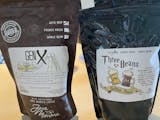The Perfect Cup?
No matter where you buy the tea or how much you spent, if you brew it wrong, it's awful.
This is a lesson many beginners learn the hard way. Most people who claim they "don't like the taste" were repelled by an incorrectly brewed tea. Similar to coffee this nightmare is easily avoided with better brewing techniques.
Steeping excellent tea isn't rocket science, but it is also not as simple as throwing it into boiling water and letting it stew. To get that perfect cup of tea involves very a few simple steeping methods. In fact, there are nearly as many brewing methods as there are teas. In this lesson, we'll go through the most effective and functional ways to infuse most any tea (and non-tea).
The trick to steeping tea correctly comes in five parts: water, weight, temperature, time and equipment.
Water
Perfect water isn't necessary, but if your water "tastes funny", so will your tea. If your water tastes great (or does not have a taste at all depending on your perspective), you should be in pretty good shape. Great water will have around 150 parts per million (PPM) of balanced mineral content. For perspective, extremely hard water in some major U.S. cities is around 900+ PPM. To correct this issue at home, you can use a simple carbon filter water pitcher to remove the extra mineral, as well as any contaminants like chlorine (unless you enjoy tea that tastes like a swimming pool).
Water that is too hard (too many minerals) will extract extra astringency from your tea and give you a harsh brew. Water that is too soft will not extract enough of the polyphenols that deliver astringency, health benefits, and taste... so you'll have a weak, grassy and gross cup. Fresh water is also best. When water boils, oxygen is released. The Chinese call water that has been boiled "dead water". You can't get the best cup of tea from water that has been repeatedly re-boiled.
Weight
Using too much tea will make your tea bitter and your wallet empty. Too little tea will bring a weak cup and a sense of longing. The volume that is considered the "golden ratio" of leaves to water is two teaspoons of most tea leaves per 8 ounces of water. Please note this is for a traditional 8-ounce cup. Most mugs are nearly twice that at 10 to 12 ounces. Here's where it gets a little complicated. A large, open leaf tea like a White tea or some Oolongs may require two or more teaspoons to equal 2 grams. Broken or tightly rolled teas like gunpowder may pack as many as 3 grams of tea into a single teaspoon. At the end of the day, perfection is less important than keeping an eye on the leaf size and adjusting based on your taste preferences.
Temperature
Don't you wish your tea was hot like me? The ideal temperature depends on the tea. Use boiling water (212 F) when preparing Black, dark Oolong and Herbal teas. These teas are tough, they can take the burn, and even require it in order to break down the leaf and release the flavor and antioxidants. However, it's important to use cooler water when steeping more delicate teas, such as Green, green Oolong and White teas. Water that is too hot will cause a delicate tea to taste overly bitter or astringent. Water that is too cool will cause the tea to taste flavorless and weak. If you don't have a thermometer or a kettle that lets you gauge temperature, you'll typically find that boiling water that is allowed to sit for 5 minutes will have dropped to roughly 180 F.
Time
They say that "time heals all wounds." However, it also makes most teas turn bitter. The rule of thumb is 3-5 minutes for most black teas, depending on your preference for strength. Any longer, and they'll become overly astringent and dry your mouth. Dark Oolong and White teas, on the other hand, are much more forgiving. These teas will taste best when steeped for 3-5 minutes but will still be drinkable if steeped a little longer. For light Oolong and green teas, a little TLC must be employed, steeping for only 2 minutes - 3 if you're looking for a strong cup.
Equipment
The proper equipment is also very important in the steeping process. When hot water is added, tea leaves can unfurl up to 5 times their dry size. So to make a great tea you need to give your leaves some leg room. If using an infuser basket, use as broad and deep of a basket as possible for the pot or cup you're brewing in (some barely extend a quarter of the way below the surface of the water). As mentioned in another lesson, commercial tea bags are not recommended, due to inadequate expansion room and low quality tea. We have an excellent selection of practical to fun tea infusers for you to choose from HERE
Which brings us to our final point. It almost goes without saying that, to make the perfect cup of tea, there is one more prerequisite: good tea. Buy the best that is within your budget. Keep it fresh, too; don't stockpile tea for next holiday season's company! Enjoy your fresh tea within 6 months to a year. It will make a noticeable difference.
The perfect cup is out there... just brew it.



